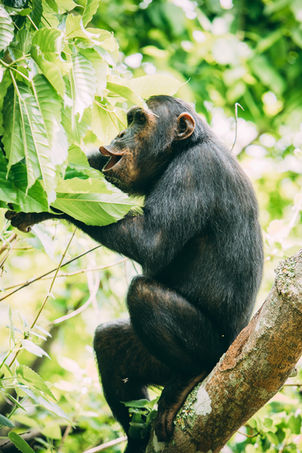
The Wildlife of Tanzania
Wildlife resources of Tanzania have been described as without parallel in Africa & the prime game viewing country.
National Parks offer protection for huge elephant and Cape buffalo herds, large hands of giraffes, zebras, hippos, a plethora of antelope, and vast amounts of crocodiles.
Predators include: lion, leopard, cheetah, Wild Dog & hyena.
All the game parks in Tanzania have an amazing variation of birdlife including Eurasian migrants. Over 1,130 different species of birds have been recorded in Tanzania – almost the largest number in Africa second only to the Democratic Republic of Congo.
Oh, and let's not forget the primates...Tanzania is the only place where Chimps and Lions co-exist!


The Big 5 plus so much more!

Zambia and Tanzania possess the largest hippo populations in Africa.
In all the parks we offer you will need a big memory card for your camera because you will see many many hippos.
The mighty Rufiji river in Nyerere is renowned for its population of hippos and crocodiles, as is Katavi renowned for interspecies competiton between its hippos and crocs during the dry season
Buffalo, Lions, and huge populations of elephants can all be ticked off of your game-viewing list.
In Nyerere there are larger populations of elephants but you not struggle to find them in Ruaha.
When Jongomero's river in Ruaha dries up then elephants come to dig under the riverbed, 300 individuals are not unusual!
10% of Africa's remaining Lions are in Ruaha National Park, while our camp in Nyerere has a resident pride of lions, and in Mahale the lions co-exist with the chimps.
Huge populations of buffalo can be found in Nyerere, Ruaha, and Katavi.
Some of Africa's last remaining black rhino populations can be found in Nyerere, although it is rare to see them.




Large Populations of African Wild Dogs occur in Nyerere and Jongomero, here they are thriving, unlike most of those elsewhere on the continent. In fact, the park has the last true stronghold for African hunting dog in Africa.
The giraffe is the national animal of Tanzania, which has strict laws to protect them.
The Masai giraffe are distinguished by jagged spots on their bodies. It is the largest-bodied giraffe species, making it the tallest land animal on Earth.
The bat-eared fox is a treat to see and a regular in Ruaha. These small foxes average just half a metre in length, with large ears roughly a quarter of their length, which are used for thermoregulation - like elephants! They are predominantly an insectivore that also use these large ears to locate their prey.



Rare Species of Antelopes including: brindled gnu, Nyasaland gnu, sable antelope, eland, greater kudu, waterbuck, hartebeest, both Lesser and Greater Kudu.
It is also possible to see, Sable and Roan antelope, Lichtenstein’s Hartebeest, Topi, both Southern and Bohor reedbuck and it is the southernmost limit of Grants Gazelle.
Primate fans will not be disappointed!
In Mahale Mountains National Park are the most passionate and experienced guides for trekking a group of chimpanzees that has been long habituated for tourism. There are of course other non-habituated groups but, seeing more than fleeting glimpse of completely wild chimps is rare. One unique place to experience chimpanzee encounters is Rubondo island, where there ex-captive and wild-born chimps are undergoing the habituation phase, currently used to humans being in the forest but, still reactive to their presence. A fully habituated group ignores the presence of humans, thus allowing a true window on their daily behaviour.
Colobus monkeys live alongside the chimps.
In most parks are the characterful yellow baboons parading around on the floor, grazing the grasses as they go. Big troops containing babies are mesmerising to watch, and impossible to not compare their behaviours to our very own.
Vervet monkeys are in abundance, frolicking their way around wherever they choose to go, sometimes this will be the camps! Maybe even Silver monkey and red-tailed monkeys, too.
At night there are pottos and galagos to be found as they prudently hunt for insects.


With 574 species recorded in Ruaha, it is difficult to visit this beautiful Park and not be impressed by the number and variety of birds you see.
In Nyerere National Park, bird life is also diverse and abundant. More than 440 species of birds have been recorded! Found in sandbanks, oxbow lakes and rivers.
The lake areas are especially favoured by giant kingfishers & pink backed pelicans as well as the African skimmer; along the sandbanks you will see the white-fronted bee-eater, fish eagle, carmine, ibises and palmnut vultures.
Superb Marine Life in Crystal Clear Waters
The coconut crab also calls the Songo Songo archipelago and Fanjove Island it's home, a species of terrestrial hermit crab, also known as the robber crab or palm thief. It is the largest land-living arthropod in the world, and is probably at the upper size limit for terrestrial animals with exoskeletons. A sight you will never forget, even if you want to! Thanks to recent conservation efforts it's population here has been augmented after years of being hunted for it's reputedly delicious meat.
This is not the only crab species on Fanjove but it is for sure the most unforgettable


Green Turtles are regularly found all year round in the crystal clear waters during snorkelling explorations.
While others turtles such as leatherbacks visit the shores seasonally for nesting.
Which means that cute little hatchlings make seasonal appearances too.
Usually about 2 months after mother has deposited them.
Different dolphin species frequent the waters around Fanjove. Spinner Dolphins and Bottlenose Dolphins are regularly spotted, and with luck you may have the opportunity to swim alongside them.
Humpback whales also visit the waters around Fanjove, when they do it is possible to take a boat tour to get closer to them and see their impressive & playful displays.
Check out the video opposite showing a dhow boat trip in Fanjove with dolphins swimming with the boat while no other tourists are insight.

























